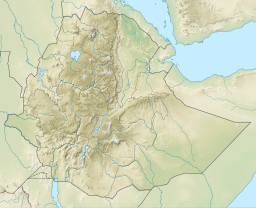Hiza'iti Wedi Cheber: Difference between revisions
Rastakwere (talk | contribs) banner became obsolete |
Citation bot (talk | contribs) m Add: doi. Removed URL that duplicated unique identifier. | You can use this bot yourself. Report bugs here.| Activated by User:Nemo bis | via #UCB_webform |
||
| Line 43: | Line 43: | ||
== Environment == |
== Environment == |
||
The [[catchment]] of the reservoir is 33 km² large, with a perimeter of 24.6 km and a length of 6910 metres. The reservoir suffers from rapid [[siltation]].<ref>{{cite journal |last1=Nigussie Haregeweyn |first1=and colleagues |title=Reservoirs in Tigray: characteristics and sediment deposition problems |journal=Land Degradation and Development |date=2006 |volume=17 |pages=211–230 | |
The [[catchment]] of the reservoir is 33 km² large, with a perimeter of 24.6 km and a length of 6910 metres. The reservoir suffers from rapid [[siltation]].<ref>{{cite journal |last1=Nigussie Haregeweyn |first1=and colleagues |title=Reservoirs in Tigray: characteristics and sediment deposition problems |journal=Land Degradation and Development |date=2006 |volume=17 |pages=211–230 |doi=10.1002/ldr.698 }}</ref> The lithology of the catchment is [[Antalo Limestone]] and Mekelle Dolerite.<ref name="joke"/> Part of the water that could be used for irrigation is lost through [[seepage]]; the positive side-effect is that this contributes to [[groundwater recharge]].<ref>{{cite journal |last1=Nigussie Haregeweyn |first1=and colleagues |title=Sediment yield variability in Northern Ethiopia: A quantitative analysis of its controlling factors |journal=Catena |date=2008 |volume=75 |pages=65–76 |doi=10.1016/j.catena.2008.04.011 }}</ref> Actually the whole valley bottom down to [[Chalacot|Chelekwot]] benefits from this seepage water, that emerges in various springs and is particularly used for irrigation agriculture. |
||
== References == |
== References == |
||
Revision as of 20:22, 29 November 2019
| Hiza’iti Wedi Cheber | |
|---|---|
 | |
| Coordinates | 13°21′48″N 39°32′35″E / 13.363202°N 39.543074°E |
| Type | Freshwater artificial lake |
| Basin countries | Ethiopia |
| Water volume | 1.24×106 m3 (1,010 acre⋅ft) |
| Surface elevation | 2,230 m (7,320 ft) |
| Settlements | Mereb Mi’iti |
Hiza’iti Wedi Cheber is a reservoir located in the Inderta woreda of the Tigray Region in Ethiopia. The earthen dam that holds the reservoir was built in 1997 by the Tigray Bureau of Agriculture and Natural Resources.[1]

Dam characteristics
- Dam height: 14.5 metres
- Dam crest length: 598 metres
- Spillway width: 30 metres
- Original capacity: 1 240 000 m³
- Designed irrigated area: 80 ha
- Actual irrigated area in 2002: 50 ha
Environment
The catchment of the reservoir is 33 km² large, with a perimeter of 24.6 km and a length of 6910 metres. The reservoir suffers from rapid siltation.[2] The lithology of the catchment is Antalo Limestone and Mekelle Dolerite.[1] Part of the water that could be used for irrigation is lost through seepage; the positive side-effect is that this contributes to groundwater recharge.[3] Actually the whole valley bottom down to Chelekwot benefits from this seepage water, that emerges in various springs and is particularly used for irrigation agriculture.
References
- ^ a b De Wit, Joke (2003). Stuwmeren in Tigray (Noord-Ethiopië): kenmerken, sedimentatie en sediment-bronnen. Unpub. M.Sc. thesis. Department of Geography, K.U.Leuven.
- ^ Nigussie Haregeweyn, and colleagues (2006). "Reservoirs in Tigray: characteristics and sediment deposition problems". Land Degradation and Development. 17: 211–230. doi:10.1002/ldr.698.
- ^ Nigussie Haregeweyn, and colleagues (2008). "Sediment yield variability in Northern Ethiopia: A quantitative analysis of its controlling factors". Catena. 75: 65–76. doi:10.1016/j.catena.2008.04.011.

